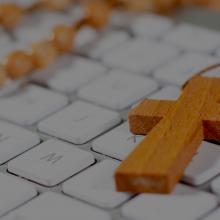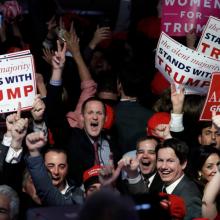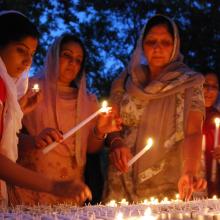Pluralism
UKRAINE IS, IN A WAY, a very pluralistic country. Nobody has an absolute majority. The Orthodox are the biggest group of believers, but they are divided into two jurisdictions — one that is independent and another one that depends, to a bigger or smaller degree, on Russia and the patriarchate of Moscow. Around 10 percent of the Ukrainian population are Catholic, mostly Eastern Catholic, and follow the same calendar and liturgy as the Orthodox. One to 2 percent are Latin Rite Catholics, and 1 to 2 percent are Protestant.
In his new book, We Need to Build, Patel seeks to inspire others to build with him instead of just criticizing policies and structures they dislike. The book draws on Patel’s work with Interfaith America and considers what we can learn from good (and bad) institutions across the globe.
I WAS ONCE on a panel with a counselor who proudly claimed her identity as a woman as the reason for her feminist approach to counseling. Toward the end of the discussion, she told the story of a client who frustrated her. A highly educated middle-aged mother of three, this woman (the client) had stepped off the career track to take care of her children. The children were now grown, and she had come to counseling to think through her next steps. My fellow panelist encouraged this client to claim her identity powerfully and express it in public fiercely. The client liked this idea. Some weeks later, she told her counselor that she had gone back to the Catholic church of her childhood and started to attend pro-life rallies.
“That wasn’t what I meant when I told her to claim her identity and express it in public,” the counselor deadpanned, and the liberal university audience laughed along with her.
The exchange left me feeling queasy. Here was a counselor purporting to empower the identity and expression of a client in a period of transition and then being disappointed that her client hadn’t chosen the identity and expression the counselor desired. And the public affirmation of the counselor in a room full of people who clearly shared her worldview felt doubly unsettling.
Pluralism is valuable because Jesus is the sovereign lord of everything — all places, people, religions, and cultures.
The American Civil Liberties Union collected more than $11 million and 150,000 new members. The Southern Poverty Law Center’s Twitter account gained 9,000 followers. And the Anti-Defamation League, which fights anti-Semitism and other bigotries, saw donations increase fiftyfold.
In the days since Donald Trump won the presidency, these spikes, in support for groups that defend religious and other minorities, speak to a fear that the president-elect will trample on their rights — or at least empower those who would.
Americans voted largely along the lines of race, education, and party identification. Nonwhites strongly preferred Clinton, while whites decisively chose Trump. Compared with past Republicans, the businessman received a stunning surge of votes from non-college-educated white voters.
None of this is surprising.
And yet the result upends so much conventional wisdom.

Rittikrai / Shutterstock
I SPEAK ON about 25 college campuses a year, which affords me a front row seat for current trends in identity politics. One of the things I’ve noticed is that when people say they are engaged in “diversity work,” what they often mean is that they are busy mobilizing their preferred identity groups toward their approved politics. The main role they see for those on the other side is to be defeated.
But the real challenge of living in a diverse democracy is not dealing with the differences you like, it’s working with the differences you don’t like.
In his excellent new book, Confident Pluralism, John Inazu, a professor at Washington University Law School and board member of InterVarsity Christian Fellowship, takes a long look at how to do this, with special attention to religious differences.
Disagreements with regard to religious matters are some of the most challenging ones around. That’s because religion is about ultimate concerns. Not only do faith traditions deal with issues—creation, salvation, morality, human purpose—that are inherently ultimate in nature, they imbue matters that may otherwise be viewed as mundane with a sense of ultimacy. That’s not just a random group of people over there, that’s the church, or the umma. That’s not just any old piece of land, that’s the place where the Second Temple once stood, or where Lord Rama was born.
Inazu opens his book with a sobering quote from the French philosopher Jean-Jacques Rousseau: “It is impossible to live at peace with those we regard as damned.”
He is reminding us right off the bat that the stakes could not be higher.

Image via chrisdorney / Shutterstock.com
Almost 1,600 years after St. Augustine founded the first Roman Catholic church at Canterbury in 597 C.E., the British people have been told in no uncertain terms that they’re no longer living in a Christian country.
A sensational report released this week by the Commission on Religion and Belief in British Public Life, challenges this country’s time–tested moral and public values system. In language that raises eyebrows — and tempers — the report says United Kingdom (U.K.) should cut back the Christian tone of major state occasions and shift toward a “pluralist character.”
Events such as a coronation should be changed to be more inclusive, it said, while the number of bishops in the House of Lords should be cut to make way for leaders of other religions.

Photo via Emka74 / Shutterstock.com
I never liked “Imagine.” I am not the only Jewish teacher who feels this way.
“Imagine there’s no countries/It isn’t hard to do/Nothing to kill or die for/And no religion too.”
Lennon was saying: Let’s get rid of nations; let’s get rid of religion; let’s get rid of the idea that there is something above me that is worth dying for, and that might even be worth killing for.
Let’s get rid of the passions that help us transcend ourselves. Maybe that’s why the melody of “Imagine” is so subdued — almost like sleepwalking.
“Imagine” is a dream, and not a very good one.

Image via Tamisclao/Shutterstock
I think the reason why the Christian Internet is so exasperating is because it is filled with so many people. Sensational click baits trend because we love juicy scandals. We share angry articles and judgmental pieces because it satisfies our human desires to point fingers and be in the right. The Internet has exposed the basest of our human fears and aired out our dirtiest laundry with the lure of anonymity and protection from our screens.
The Christian Internet is all of us with our mess, our flaws, our brokenness, our hurts, our mistakes, and our pains. Which means that as hard as it is for us to see through the hazy noise pollution, behind every instigator of a mean meme is a person made in the image of God. And as long as I believe that is true, you can’t pry me away from the Christian Internet because I am not about to miss the astounding beauty that is sure to rise from the squabbling ashes.
SUMMER IS READNG time and there’s nothing I like more during the warm months than delving into geeky works on religion. This summer, Peter L. Berger and Brian D. McLaren have topped my list.
In a set of recent essays, Berger emphasizes that relativism and fundamentalism are two of the most prominent religious paths in the world today. Here’s my one line definition of fundamentalism: “Being me is based on dominating you.” And my simple definition of relativism: “I no longer know who I am when I encounter you.”
For Berger, while relativism and fundamentalism are at opposite extremes, they are actually closely connected in that they are both “products of the same proc-ess of modernization.” As he first wrote decades ago in his book The Heretical Imperative, frequent and intense encounters between people with different identities is the signature characteristic of the modern era. In Berger’s pithy phrase: modernity pluralizes.
Berger continues, “pluralism relativizes ... both institutionally and in the consciousness of individuals.” In the pre-modern era, institutions, ideas, and identities had a largely taken-for-granted status. For most of human history, the vast majority of humankind had little to no choice about which institutions they were going to participate in or what their identities were going to be. Such matters were experienced as fate.
THE FUNCTION of healthy religion and church is to provide individuals and society with a collective container that carries the objective truth of reality for individuals. The Great Truth is too grand and transcultural to be entrusted to the vagaries of individuals and epochs. Otherwise, society becomes a massive runway for unidentifiable flying objects—each claiming absolute validity and turning their subjectivity into the only sacred.
The ground for a common civilization and shared values is destroyed if our religious experience is basically unshareable or without coherent meaning. We end up where we are today: pluralism without purpose, individuation but no community.
THE SAGA OF Elijah that we are following in 1 and 2 Kings culminates in a poignant parting as the prophet prepares to be taken up into heaven. His disciple, Elisha, makes a final all-or-nothing request: “Please let me inherit a double share of your spirit” (2 Kings 2:9). Elijah states a condition for the fulfillment of Elisha’s prayer: “You have asked a hard thing; yet, if you see me as I am being taken from you, it will be granted you; if not, it will not” (2:10). It is as if Elisha has to look unblinkingly into the reality of their separation. If he is to inherit the prophetic mantle and spirit of his teacher, he must claim the vocation in its entirety. He is now to be the prophet.
The story is an uncanny pointer to the truth that John the Evangelist highlights in Jesus’ last words to his disciples: “I tell you the truth: It is to your advantage that I go away, for if I do not go away, the Advocate will not come to you ...” (16:7). John even echoes the “double spirit” theme in 14:12, when he has Jesus assure us that our prophetic endeavors will be more abundant and powerful than Jesus’ own!
The season following Pentecost helps us realize that we are the prophets now, vested with the mandate and endowed with the gifts for enacting the good news of liberation.
THE TERM “DIVERSITY” in professional and educational circles in the United States is frequently mentioned as positive on its face, needing no justification. “Diversity is our strength” or “diversity enriches us” are common statements.
But Harvard professor of comparative religion Diana Eck points out that diversity is simply a demographic fact—a situation in which people with different identities live in close quarters. The term says nothing about how those people get along with one another. Frankly, if all we knew about religious diversity in particular were the stories carried on the international news, it would be hard to conclude anything except that the close gathering of Muslims, Christians, Jews, Buddhists, Hindus, and others is nothing but a recipe for conflict.
Religious conflict is especially deadly because the participants believe they are fighting for cosmic reasons—where death may be welcomed as martyrdom—and religious communities are the largest repositories of social capital in many civil societies, providing endless amounts of energy, people, and resources to mobilize.
But what if the social capital among religious communities could be bridged and people who orient around religion differently could be convinced to cooperate with one another? What if the cosmic narratives of religious traditions viewed people of other faiths as partners in the quest for the kingdom on earth? This is the hope of the interfaith movement, and building this movement is the job of interfaith leaders.
WHO SHOULD BE able to pray at a presidential inauguration and what should that prayer be?
On Jan. 20, 1937, Monsignor John A. Ryan delivered the first inaugural benediction at the inauguration of Franklin D. Roosevelt with these words: "Almighty God, ruler of nations, we beseech thee to bless the people of the United States. Keep them at peace among themselves and in concord with all other peoples. Cause justice and charity to flourish among them, that they may all be enabled to live as persons created in thine own image and likeness."
Since this first benediction, ministers, priests, bishops, cardinals, and rabbis have offered prayers at the past 18 presidential inaugurations. Almost 76 years to the day since Father Ryan's benediction, Myrlie Evers-Williams became the first layperson to deliver the inaugural invocation, and Rev. Luis León, an Episcopal priest, offered his prayer for President Obama and our nation: "... with the blessing of your blessing, we will see that we are created in your image, whether brown, black, or white, male or female, first-generation immigrant American or daughter of the American Revolution, gay or straight, rich or poor ... with your blessing we will recognize the abundance of the gifts of this good land with which you have endowed this nation."
You may remember that the selection of Rev. León, like most decisions made in Washington today, did not come without controversy and an onslaught of protests. León, who ministers at St. John's Church near the White House and is known for welcoming openly gay Christians, replaced the administration's first choice, Rev. Louie Giglio. Giglio withdrew from the ceremony after the surfacing of his controversial sermon from 20 years ago condemning gay relationships. Giglio's stance on the issue of gay marriage is in sharp contrast to the beliefs of Rev. León, whose parish will begin to bless same-sex partnerships and ordain transgender priests this summer.
PERHAPS NO FRAMEWORK has impacted my organization, Interfaith Youth Core, more than Marshall Ganz’s approach to public narrative (“leadership storytelling”), best articulated in his March 2009 Sojourners article “Why Stories Matter.” We use it in our trainings with college student interfaith leaders and recommend it in the workshops we do with university faculty. Most famously, it was employed by the 2008 Obama campaign.
Like all effective frameworks, there is both a visceral and a heady quality to what Ganz teaches. Stories are the way human beings understand and communicate our deepest values, Ganz says, and there are three major stories that leaders must tell. The first is the story of self. This is not a selfish activity, or even one just about self-understanding (although that is certainly a piece of it). It’s about interpreting to others your reasons for being engaged in a struggle. This helps them understand your involvement and, more important, gives them inspiration and language to get active themselves.
The second type of story is the story of us. Religions, races, ethnicities, and nations tell such stories brilliantly but often do it in a way that excludes—and makes enemies of—those outside the magic circle. The challenge for the 21st century leader is to tell a story of us that includes people of all backgrounds who are fighting for the same cause. Stories of us build community out of people who would otherwise be strangers.
Congress will become a shade more religiously diverse this January, after Tuesday’s election of the first Hindu representative and first Buddhist senator.
Tulsi Gabbard, a Democrat from Hawaii, will become the first Hindu-American congresswoman, after defeating her Republican rival on Tuesday.
OURS IS AN age of interaction, mobility, and change. Unlike most of our grandparents, many of us have moved several times in our lifetimes and have seen our neighbors move in and out. We are more intensely aware, even in our own neighborhoods, that our kind of faith is not the only kind. We see how others have been shaped by very different histories than our own. It becomes clear to us that we, too, have been shaped—and continue to be shaped—by our own history.
Fuller Theological Seminary, where I teach, is in California. Every now and then we feel the ground shifting. The chandelier in our dining room swings or the bed on which we are lying begins to rock. The whole world may not be experiencing little earthquakes as we are, but people are surely experiencing change and variety in faiths and ideologies. This change and diversity can rock a person’s faith. We ask, How do we validate the truth of what we perceive and what we believe? In our time of pluralistic encounter with multiple ideologies and religions and with rapid social, economic, and political change, people search for what Dietrich Bonhoeffer called solid ground to stand on.
Philip Clayton teaches at Claremont Theological Seminary in California. He attended the mainline Presbyterian church that had been his church home since elementary school, plus an evangelical Bible study group, a charismatic prayer meeting once a week in a Pentecostal church, the Assemblies of God church, and a community of “Jesus People.” He writes:
Most of us know friends, colleagues, or acquaintances who are Christian, Jewish, Muslim; Buddhist, Hindu, Taoist; atheist, agnostic, “doubting believers”; pantheist, panentheist, neo-pagan; Mormon, Jehovah’s Witness, Church of God; Baha’i, Zoroastrian, perennialist—the list goes on and on. Faced with such a confusing array of options, more and more Americans are choosing not to choose ... You have to admit, pretty much everything these days is up for grabs. We are in the midst of the most rapid social and technological change that our species has ever undergone.
Imagine the terror.
You are in a temple, a safe, sacred place, preparing for a morning service. In the kitchen, you are busy cooking food for lunch, while others read scriptures and recite prayers. Friends begin to gather for the soon-to-start service.
At the front door, you smile at the next man who enters. He does not smile back. Instead, he greets you with hateful stare and bullets from his gun.
Such was the scene Sunday at a Sikh gurudwara in Oak Creek, Wis., just south of Milwaukee, where a gunman, Wade Michael Page, killed six and critically injured three others before being shot down by law enforcement agents.
As Page began his shooting spree, terrified worshippers sought shelter in bathrooms and prayer rooms. Rumors of a hostage situation surfaced, and those trapped inside asked loved ones outside not to text or call their cell phones, for fear that the phone ring might give away their hiding place.
The first police officer to arrive on the scene stopped to tend to a victim outside the gurudwara. He looked up to find the shooter pointing his gun directly at him, and then took several bullets to his upper body. He waved the next set of officers into the temple, encouraging them to help others even as he bled.
That magnanimity is a common theme among the stories of victims and survivors of the Wisconsin shootings. Amidst terror and confusion, Sikhs offered food and water to the growing crowd of police and news reporters outside the gurudwara as part of langar — the Sikh practice of feeding all visitors to the house of worship.
Ralph Singh, director of publications and public relations for Gobind Sadan — "God's House Without Walls," a spiritual community rooted in the Sikh tradition with locations in India and the United States — responds to the mass shooting at a Wisconsin Sikh gurudwara that has devastated the faith community.
Sikhism was founded more than 500 years ago in India. Observant Sikhs do not cut their hair, and male followers of the religion wear turbans, which they consider sacred.
"A Sikh, wherever they go in the world, is committed to building community a community of peace, an inclusive community to stand as an affirmation of what we now call pluralism," Singh says.
Listen to what Singh as to say on a video inside the blog ...













